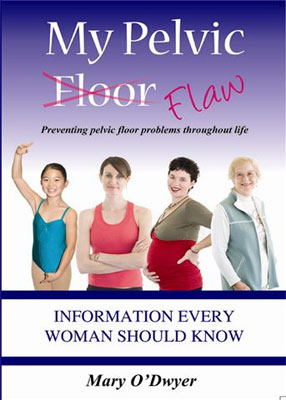My Pelvic Flaw: preventing pelvic floor problems thoughout life

"We work on the rest of our bodies, why not our pelvic floor? We all need help on how to work it."
Susie O'Neill. Olympic and Commonwealth Games Gold Medalist.
"Today, women's worst habit contributing to pelvic floor problems is constantly drawing back the waist to flatten their stomach. Researchers show that narrowing the abdomen at the waist, increases pressure inside the abdomen which in turn puts pressure down on the pelvic floor." Mary O'Dwyer. Physiotherapist and Pelvic Floor Coach.
This is just one of the flaws speaker and author Mary O'Dwyer highlights in her book My Pelvic Flaw, which contains new evidence based information to help women learn the facts.
With more than 30 years clinical and teaching experience, O'Dwyer has helped many women through all stages of life - children, pregnant and post birth mums, menopausal and senior women overcome their pelvic floor problems.
"Today, there is an epidemic of pelvic floor dysfunction that women generally accept as part of being female. Great emphasis is placed on training our bodies, while the pelvic floor is completely ignored", she says.
O'Dwyer also conducts seminars teaching physiotherapists about the pelvic floor and gym trainers about the effects of exercise on weak pelvic floors. Women are at a higher risk of pelvic floor damage from incorrect exercises at the gym following childbirth, pelvic surgery or around menopause. Sit ups, crunches, double leg lifts are unsuitable exercises for many women and can promote prolapse but many women and gym instructors are unaware of this.
The book contains information for all female life stages:
What has my waist got to do with my pelvic floor?
What has breathing got to do with my pelvic floor?
Why do some women experience pain with sex?
How can sit ups cause pelvic floor problems?
What can I teach my children about their pelvic floor?
Why do elite athletes without children have pelvic floor problems?
Susie O'Neill. Olympic and Commonwealth Games Gold Medalist.
"Today, women's worst habit contributing to pelvic floor problems is constantly drawing back the waist to flatten their stomach. Researchers show that narrowing the abdomen at the waist, increases pressure inside the abdomen which in turn puts pressure down on the pelvic floor." Mary O'Dwyer. Physiotherapist and Pelvic Floor Coach.
This is just one of the flaws speaker and author Mary O'Dwyer highlights in her book My Pelvic Flaw, which contains new evidence based information to help women learn the facts.
With more than 30 years clinical and teaching experience, O'Dwyer has helped many women through all stages of life - children, pregnant and post birth mums, menopausal and senior women overcome their pelvic floor problems.
"Today, there is an epidemic of pelvic floor dysfunction that women generally accept as part of being female. Great emphasis is placed on training our bodies, while the pelvic floor is completely ignored", she says.
O'Dwyer also conducts seminars teaching physiotherapists about the pelvic floor and gym trainers about the effects of exercise on weak pelvic floors. Women are at a higher risk of pelvic floor damage from incorrect exercises at the gym following childbirth, pelvic surgery or around menopause. Sit ups, crunches, double leg lifts are unsuitable exercises for many women and can promote prolapse but many women and gym instructors are unaware of this.
The book contains information for all female life stages:
What has my waist got to do with my pelvic floor?
What has breathing got to do with my pelvic floor?
Why do some women experience pain with sex?
How can sit ups cause pelvic floor problems?
What can I teach my children about their pelvic floor?
Why do elite athletes without children have pelvic floor problems?
Interview with Mary O'Dwyer on My Pelvic Flaw
1. Why do you say that drawing in the waist is one of women's worst habits?
If a woman continually draws her abdomen in at the waist, her brain may learn to constantly switch on these muscles when she lifts or works out at the gym. When we cough or lift, we should automatically tension our pelvic floor and deep abdominal, but instead we learn forceful drawing back at the waist. This in turn creates more pressure inside the abdomen which pushes down onto, and can overwhelm the pelvic floor.
2. Do athletic women have strong pelvic floor muscles?
Studies show that 28 to 52% of elite female athletes have stress and or urge incontinence. Often athletic women have pelvic floors that are held too tightly and this makes them weak and uncoordinated.
3. Does a Caesarian section protect you against pelvic floor problems?
Childbirth is a cause of muscle damage with some difficult births. However, researchers show that after vaginal delivery 42% of women have some incontinence and prolapse. The C section mums had a 35% rate of incontinence and prolpase. Women who have a C section usually don't think about rehabilitating the deep abdominal and pelvic floor after delivery.
4. Sit ups and crunches are recommended to flatten the stomach, so why do you say these exercises may be wrong for women?
Sit ups cause a big rise in intra abdominal pressure which pushes down onto the pelvic floor. If a woman has a pre weakened pelvic floor, or no idea of how to tension her floor, these abdominal exercises can aggravate incontinence and prolapse. Abdominal muscles are not meant to be trained in isolation- the deeper and outer abdominal groups are meant to all tension together in a co-coordinated pattern. Training abdominal muscles in isolation risks training a faulty pattern of movement.
5. Surely surgery can repair any problems down the track?
Surgery can restore a woman's quality of life and improved bladder and bowel function. We need to adopt the mind set of prevention rather than relying on surgery as a quick fix. Researchers show that 38% of women post hysterectomy suffer from sexual dysfunction(pain with intercourse, less vaginal sensation, decreased orgasm). 30% of women re prolapse again after repair surgery.
6. Can pelvic floor exercises improve orgasms?
Research shows that women who have incontinence and sexual dysfunction report a high rate of improvement in their orgasm and vaginal sensation after a programme of pelvic floor muscles retraining. Strong pelvic floor muscles = stronger orgasm.
7. What everyday habits help pelvic floor function throughout life?
Sitting upright keeps the pelvic floor and deep abdominal muscles switched on
Relax a tightly held waist
Breathe in by opening your stomach out
Learn to tension your pelvic floor muscles as you breathe out
Control an urgent bladder by emptying no more than 5 or 6 times a day
Eat adequate fiber rich foods to avoid straining to empty the bowel
8. What was your inspiration behind the book?
My patients - women's quality of life, self esteem, ability to exercise and personal relationships can be dramatically affected by pelvic floor dysfunction. I wrote this book to transform women's knowledge of their pelvic floor and to learn the correct information to teach their daughters and help change the present epidemic of pelvic floor problems.
9. Have you always wanted to be a writer? What was the turning point that cemented your carreer?
I thought I was the most unlikely person to write a book. The turning point happened after years of hearing women say 'Why didn't someone tell me this before?' or 'Where can I get this information to send my daughter?' I would sit there with a goofy look on my face and say 'Well there's not much available'. Eventually I had to do something about this information gap in women's pelvic floor knowledge.
10. What types of books do you like to read?
I mostly read non fiction (love Maryanne Williamson) and will read any of Tim Winton's work.
11. How lengthy is the process behind writing a novel?
This book took 2 years of solid work from start to finish.
12. What is your favorite part of being a writer?
The feedback I get about how the information has helped change someone's life.
Quick questions
Full Name: Mary Rose O'Dwyer
Nickname: Rosie
Star Sign: Aquarius
Book Category: Non fiction
Favorite Food: Roasted veges- it's really Nutella
Favorite Film: Love Actually
Favorite Actor: Kate Blanchett
Pet: My Princess cat - Pearl Jam
Describe yourself in three words: Loyal, enquiring, quixotic
Person you would most like to meet: Oprah
Hobbies/Interests: Creating havoc with my power hedge trimmer
First Job: Tray Maid at a private hospital aged 15
What can you never leave home without: Pawpaw ointment for my lips
What is the first thing you think of when you wake up in the morning: How blessed I am to have another day to enjoy
My Pelvic Flaw
Author: Mary O-Dwyer
ISBN: 9780980399905
RRP: $24.95
The best investment a woman can make for her pelvic floor is to visit a P.F. Physiotherapist and learn the correct, co-coordinated tensioning action between the pelvic floor and deep abdominal muscles. My Pelvic Flaw (Redsok) available all book stores or online www.redsok.com.au
Other flaws highlighted include:
o Lifting heavy objects. Recent Scandinavian study showed that when compared with the normal population, assistant nurses had a 60% increased risk of developing lumbar disc or vaginal prolapse due to heavy lifting.
o Thinking that a Caesarean delivery protects a woman from pelvic floor damage. Studies show that 42% of women who deliver vaginally have incontinence and prolapse, compared to 35% of women who deliver by a C section.
o Thinking that female athletes have strong pelvic floors. Studies show that up to 52% of elite female athletes have stress and or urge incontinence (these women had no children)
o Accepting sexual dysfunction. Loss of vaginal sensation, a weaker orgasm or urine loss with intercourse can lessen a woman's desire to have sex. Research has shown marked improvements in their sexual function after improving their incontinence and prolapse.
My Pelvic Flaw will show you how to find and control your pelvic floor muscles, regain bladder control, strengthen your orgasm, prevent and control vaginal collapse, recover after pelvic surgery and control your stomach muscles after childbirth.
O'Dwyer hopes that all women can benefit from her expertise and talk about it to their mothers, daughters, friends, cousins and aunts to help prevent pelvic floor problems throughout life.
Mary O'Dwyer is a pelvic floor physiotherapist trained at the Universities of Queensland and Melbourne. With more than 30 years clinical and teaching experience, Mary is currently a consultant at Physiocare in Maroochydore and Senior Teaching Fellow at Bond University, Gold Coast.
Mary conducts seminars teaching physiotherapists about the pelvic floor and back pain, and gym trainers about the effects of exercise on the pelvic floor. She also teaches Tai Chi for arthritis, runs Pilates-based pelvic floor exercise classes and strength training classes for women.
Having witnessed the effect of pelvic floor dysfunction from her patients' stories, Mary is determined to educate women about their pelvic floor health, to enlighten and empower them in the management of relevant problems, while giving them the confidence to make informed decisions.
Mary has raised three children who are now pursuing careers of their own. Her interests include travel, cooking, Tai Chi, her tropical garden and zooming around South East Queensland on the pillion seat of her husband's motorcycle - the best place to do pelvic floor exercises!
www.mypelvicfloor.info
If a woman continually draws her abdomen in at the waist, her brain may learn to constantly switch on these muscles when she lifts or works out at the gym. When we cough or lift, we should automatically tension our pelvic floor and deep abdominal, but instead we learn forceful drawing back at the waist. This in turn creates more pressure inside the abdomen which pushes down onto, and can overwhelm the pelvic floor.
2. Do athletic women have strong pelvic floor muscles?
Studies show that 28 to 52% of elite female athletes have stress and or urge incontinence. Often athletic women have pelvic floors that are held too tightly and this makes them weak and uncoordinated.
3. Does a Caesarian section protect you against pelvic floor problems?
Childbirth is a cause of muscle damage with some difficult births. However, researchers show that after vaginal delivery 42% of women have some incontinence and prolapse. The C section mums had a 35% rate of incontinence and prolpase. Women who have a C section usually don't think about rehabilitating the deep abdominal and pelvic floor after delivery.
4. Sit ups and crunches are recommended to flatten the stomach, so why do you say these exercises may be wrong for women?
Sit ups cause a big rise in intra abdominal pressure which pushes down onto the pelvic floor. If a woman has a pre weakened pelvic floor, or no idea of how to tension her floor, these abdominal exercises can aggravate incontinence and prolapse. Abdominal muscles are not meant to be trained in isolation- the deeper and outer abdominal groups are meant to all tension together in a co-coordinated pattern. Training abdominal muscles in isolation risks training a faulty pattern of movement.
5. Surely surgery can repair any problems down the track?
Surgery can restore a woman's quality of life and improved bladder and bowel function. We need to adopt the mind set of prevention rather than relying on surgery as a quick fix. Researchers show that 38% of women post hysterectomy suffer from sexual dysfunction(pain with intercourse, less vaginal sensation, decreased orgasm). 30% of women re prolapse again after repair surgery.
6. Can pelvic floor exercises improve orgasms?
Research shows that women who have incontinence and sexual dysfunction report a high rate of improvement in their orgasm and vaginal sensation after a programme of pelvic floor muscles retraining. Strong pelvic floor muscles = stronger orgasm.
7. What everyday habits help pelvic floor function throughout life?
Sitting upright keeps the pelvic floor and deep abdominal muscles switched on
Relax a tightly held waist
Breathe in by opening your stomach out
Learn to tension your pelvic floor muscles as you breathe out
Control an urgent bladder by emptying no more than 5 or 6 times a day
Eat adequate fiber rich foods to avoid straining to empty the bowel
8. What was your inspiration behind the book?
My patients - women's quality of life, self esteem, ability to exercise and personal relationships can be dramatically affected by pelvic floor dysfunction. I wrote this book to transform women's knowledge of their pelvic floor and to learn the correct information to teach their daughters and help change the present epidemic of pelvic floor problems.
9. Have you always wanted to be a writer? What was the turning point that cemented your carreer?
I thought I was the most unlikely person to write a book. The turning point happened after years of hearing women say 'Why didn't someone tell me this before?' or 'Where can I get this information to send my daughter?' I would sit there with a goofy look on my face and say 'Well there's not much available'. Eventually I had to do something about this information gap in women's pelvic floor knowledge.
10. What types of books do you like to read?
I mostly read non fiction (love Maryanne Williamson) and will read any of Tim Winton's work.
11. How lengthy is the process behind writing a novel?
This book took 2 years of solid work from start to finish.
12. What is your favorite part of being a writer?
The feedback I get about how the information has helped change someone's life.
Quick questions
Full Name: Mary Rose O'Dwyer
Nickname: Rosie
Star Sign: Aquarius
Book Category: Non fiction
Favorite Food: Roasted veges- it's really Nutella
Favorite Film: Love Actually
Favorite Actor: Kate Blanchett
Pet: My Princess cat - Pearl Jam
Describe yourself in three words: Loyal, enquiring, quixotic
Person you would most like to meet: Oprah
Hobbies/Interests: Creating havoc with my power hedge trimmer
First Job: Tray Maid at a private hospital aged 15
What can you never leave home without: Pawpaw ointment for my lips
What is the first thing you think of when you wake up in the morning: How blessed I am to have another day to enjoy
My Pelvic Flaw
Author: Mary O-Dwyer
ISBN: 9780980399905
RRP: $24.95
The best investment a woman can make for her pelvic floor is to visit a P.F. Physiotherapist and learn the correct, co-coordinated tensioning action between the pelvic floor and deep abdominal muscles. My Pelvic Flaw (Redsok) available all book stores or online www.redsok.com.au
Other flaws highlighted include:
o Lifting heavy objects. Recent Scandinavian study showed that when compared with the normal population, assistant nurses had a 60% increased risk of developing lumbar disc or vaginal prolapse due to heavy lifting.
o Thinking that a Caesarean delivery protects a woman from pelvic floor damage. Studies show that 42% of women who deliver vaginally have incontinence and prolapse, compared to 35% of women who deliver by a C section.
o Thinking that female athletes have strong pelvic floors. Studies show that up to 52% of elite female athletes have stress and or urge incontinence (these women had no children)
o Accepting sexual dysfunction. Loss of vaginal sensation, a weaker orgasm or urine loss with intercourse can lessen a woman's desire to have sex. Research has shown marked improvements in their sexual function after improving their incontinence and prolapse.
My Pelvic Flaw will show you how to find and control your pelvic floor muscles, regain bladder control, strengthen your orgasm, prevent and control vaginal collapse, recover after pelvic surgery and control your stomach muscles after childbirth.
O'Dwyer hopes that all women can benefit from her expertise and talk about it to their mothers, daughters, friends, cousins and aunts to help prevent pelvic floor problems throughout life.
Mary O'Dwyer is a pelvic floor physiotherapist trained at the Universities of Queensland and Melbourne. With more than 30 years clinical and teaching experience, Mary is currently a consultant at Physiocare in Maroochydore and Senior Teaching Fellow at Bond University, Gold Coast.
Mary conducts seminars teaching physiotherapists about the pelvic floor and back pain, and gym trainers about the effects of exercise on the pelvic floor. She also teaches Tai Chi for arthritis, runs Pilates-based pelvic floor exercise classes and strength training classes for women.
Having witnessed the effect of pelvic floor dysfunction from her patients' stories, Mary is determined to educate women about their pelvic floor health, to enlighten and empower them in the management of relevant problems, while giving them the confidence to make informed decisions.
Mary has raised three children who are now pursuing careers of their own. Her interests include travel, cooking, Tai Chi, her tropical garden and zooming around South East Queensland on the pillion seat of her husband's motorcycle - the best place to do pelvic floor exercises!
www.mypelvicfloor.info
MORE



